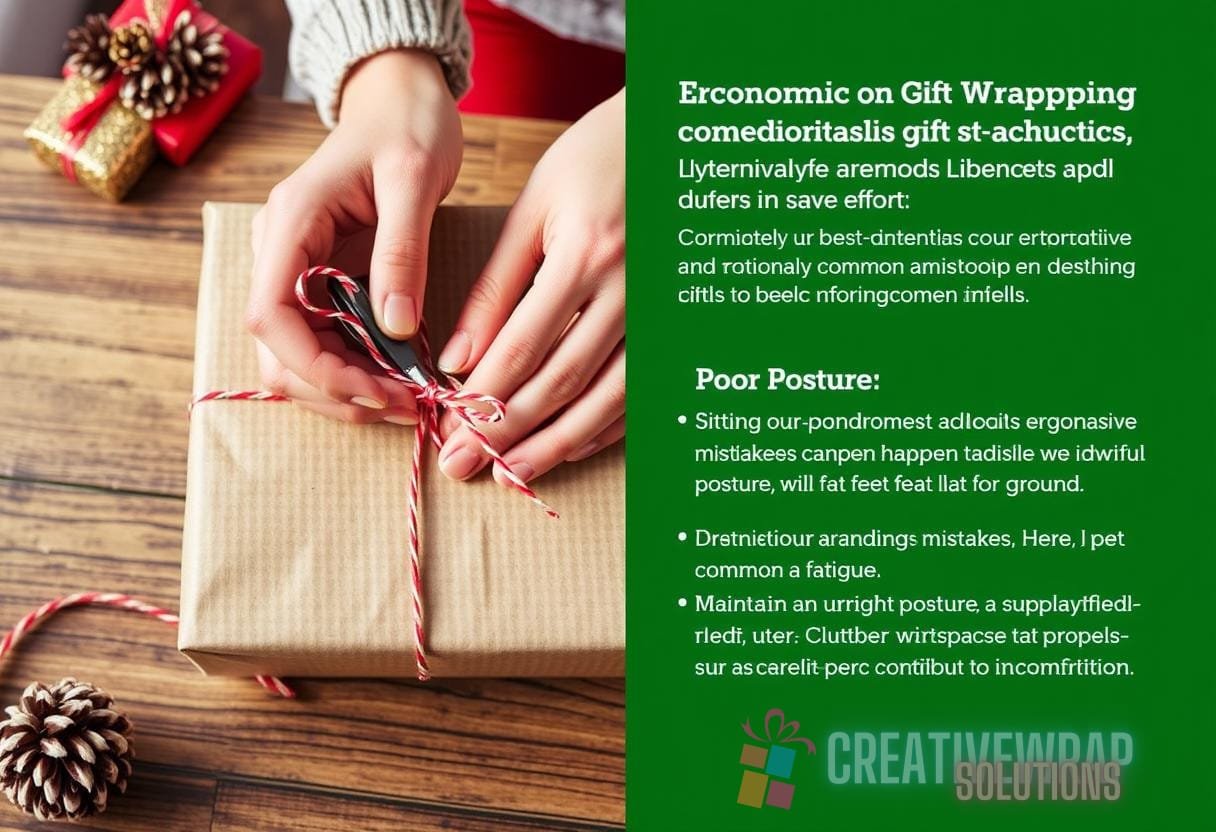Exploring the Fusion of Aesthetics and Functionality: A Scientific Approach to Ergonomic Gift Wrapping Techniques
Understanding the art of gift wrapping transcends beyond mere aesthetics; it involves a significant aspect of ergonomics to enhance the experience for both the giver and receiver. Ergonomic gift wrapping techniques focus on the physiological and psychological aspects of wrapping gifts, ensuring that the process is not only visually appealing but also comfortable and efficient for the individual wrapping the gift. This guide will explore various ergonomic gift wrapping techniques, the science behind them, and practical applications to maximize comfort and minimize discomfort during the wrapping process.
The Importance of Ergonomics in Gift Wrapping
Ergonomics is defined as the study of people’s efficiency in their working environment. Gift wrapping, while often seen as a simple task, can lead to physical strain if not approached thoughtfully. Research by the Occupational Safety and Health Administration (OSHA) highlights the prevalence of repetitive strain injuries associated with common hand tasks, including wrapping gifts. Notable ergonomic principles that can be applied include:
- Posture: Maintaining an optimal posture while wrapping to prevent back and neck strain.
- Tool Use: Utilizing ergonomic tools (like scissors and tape dispensers) to reduce tool-related strain.
- Organization: Creating an organized wrapping station to minimize unnecessary movements.
Gathering the Right Tools for Ergonomic Gift Wrapping
The effectiveness of ergonomic gift wrapping begins with having the right tools at your disposal. Selecting appropriate materials and tools can significantly enhance comfort and efficiency during the wrapping process.
Essential Tools for Ergonomic Gift Wrapping
When embarking on your gift-wrapping journey, consider sourcing the following tools:
- Ergonomic Scissors: Designed to minimize strain on your hands with a comfortable grip that doesn’t require excessive force.
- Self-Adhesive Tape Dispenser: A hands-free dispenser reduces the need for manual manipulation of the tape roll.
- Wrapping Paper Cutter: This tool ensures a clean cut with less effort, preventing awkward arm movements.
- Wrap Boards: A flat surface with measurement marks can facilitate easier cutting and folding.
- Seating Arrangement: Comfortable seating while wrapping can enhance your posture and minimize fatigue.
Setting Up Your Ergonomic Gift Wrapping Station
Creating an ergonomic gift wrapping station is crucial. The organization of your workspace can directly impact the way you wrap gifts. Consider these elements when setting up your station:
- Height-Adjusted Table: Having a work surface at the right height can alleviate strain on your back and shoulders.
- Accessibility: Keep all tools within arm’s reach to minimize reaching and stretching.
- Use a Lazy Susan: Place your materials on a rotating tray to easily access items without moving your position extensively.

The Science Behind Ergonomic Gift Wrapping Techniques
To fully appreciate ergonomic gift wrapping, understanding the biomechanics involved is essential. Studies have shown that poorly designed tasks can lead to diminished performance and increased risk of injury. The American Journal of Industrial Medicine outlines these key factors related to ergonomic efficiency:
- Repetition: Tasks performed repetitively can lead to strain injuries. Varying your movements can alleviate this risk.
- Force: Applying excessive force during gift-wrapping tasks can cause fatigue. Utilize tools that require minimal physical effort.
- Awkward Positions: Unnatural body positions can lead to discomfort. Ensure that the wrapping process maintains neutral body alignment.
Techniques for Ergonomic Gift Wrapping
Now that we understand the importance and science of ergonomics, let’s delve into specific techniques that can be applied during the gift-wrapping process.
1. Efficient Paper Cutting and Measuring
Instead of using awkward scissor techniques, employ a cutting mat or a rotary cutter. Here’s how:
- Measure the width and length of your gift and add an extra inch to each side for overlap.
- Use a ruler and the rotary cutter on the mat for clean, straight cuts.
2. Folding Techniques to Reduce Strain
Effective folding reduces the need for repetitive back-and-forth movements:
- After cutting, lay the gift in the center of the paper.
- Fold each side over gently, then press down with your palm to avoid overexertion.
3. Utilizing Non-Adhesive Techniques
To minimize frustration with tape:
- Think of using foldable papers and embellishments like ribbons that hold without adhesive.
- Alternatively, use self-adhesive methods sparingly to save effort.

Common Ergonomic Mistakes in Gift Wrapping
Despite our best intentions, ergonomic mistakes can happen during gift wrapping. Here, we identify common pitfalls:
- Poor Posture: Sitting or standing awkwardly can lead to fatigue. Maintain an upright posture with feet flat on the ground.
- Cluttered Workspaces: Disorganization can lead to excessive stretching and reaching. Maintain a clean and well-organized station.
- Cardboard Boxes: Often used for firm support, these can be awkward to navigate. Choose lightweight and flexible containers instead.
Impact of Ergonomic Gift Wrapping on Health
Research indicates that poor ergonomic practices can significantly affect health in the long term. A study published in the Journal of Occupational Rehabilitation noted that individuals who practiced ergonomically sound techniques experienced fewer symptoms of pain and increased productivity. Here are some health benefits associated with ergonomic gift wrapping:
- Reduced Risk of Strain Injuries: Proper techniques reduce the likelihood of strain and repetitive injury.
- Enhanced Comfort: A comfortable wrapping experience can make the task enjoyable rather than a chore.
- Increased Productivity: Efficient practices lead to less time spent wrapping and more quality time with loved ones.
Case Study: Implementing Ergonomic Gift Wrapping Techniques
In a comparative study conducted by researchers at the University of Ergonomics, two groups were instructed to wrap gifts using differing methods: one using traditional techniques and the other employing ergonomic gift wrapping techniques.
The following results were observed:
- Group A (Traditional): Reported discomfort after 15 minutes, leading to cessation of wrapping and a longer overall time spent on the activity.
- Group B (Ergonomic Techniques): Experienced minimal physical discomfort, leading to increased task duration efficiency and overall satisfaction.
Conclusion and Future Considerations
By seamlessly integrating aesthetics with functionality through ergonomic gift wrapping, individuals can ensure that the act of gift giving remains joyous and free from the burden of physical strain. Understanding the principles of ergonomic gift wrapping—utilizing the right tools, arranging your workspace effectively, and applying sound techniques—can transform the wrapping experience.
As more people acknowledge the importance of ergonomics in daily tasks, the realm of gift wrapping continues to evolve, adapting to new findings and innovations aimed at providing comfort and efficiency. For more tips on maintaining healthy practices during gift wrapping, consider visiting Ergonomics Organization and explore their range of resources.
For readers interested in additional resources related to gift wrapping techniques or the application of ergonomics, check out our informative articles on ergonomic principles and gift wrapping tutorials.


